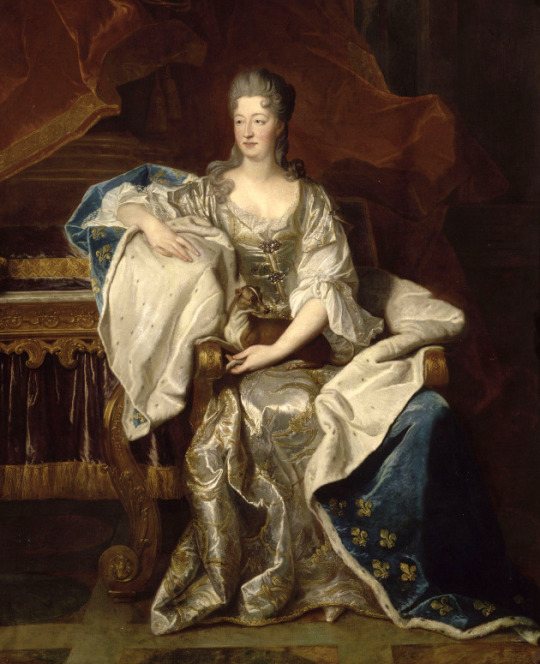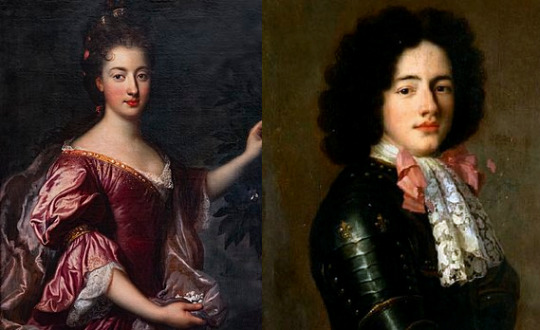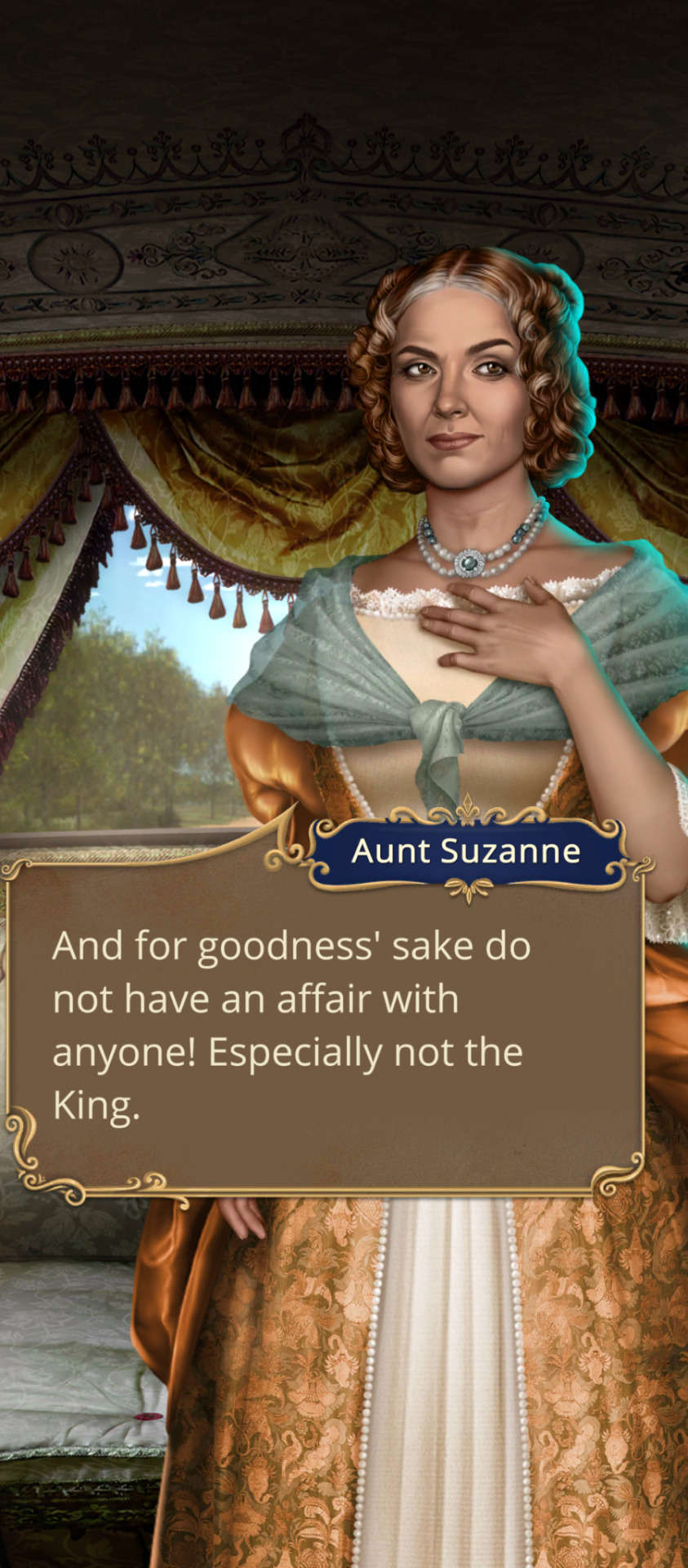#duchesse de La Vallière
Text

Marie-Anne de Bourbon (1666-1739). Atelier de Hyacinthe Rigaud.
#hyacinthe rigaud#royaume de france#maison de bourbon#marie anne de bourbon#mademoiselle de blois#blois#fils et filles de france#fille de france#royal bastards#fille légitimée#fils et filles de louis xiv#princesse de conti#bourbon conti#maison de conti#duchesse de La Vallière#duchesse de Vaujours#kingdom of france#house of bourbon
7 notes
·
View notes
Note
since you clearly know your history, do you think aegon iv's situation with his mistresses while he was king was handled realistically? weren't official king's mistresses married off before taking on their positions because any bastard children sired needed a legal father? falena was married off but there's no mention of barba, melissa, or the other women after aegon iv ascended having husbands. i mean, obviously barba needed to be unwed so she could have a chance of becoming queen but if melissa wanted to establish herself as a non-grasping replacement, shouldn't she go get a husband so naerys, aemon, and daeron couldn't feel threatened? and even if melissa was a super nice person, how she could she remain "well-loved" at court while publicly having bastards and one of them is an albino? wouldn't her reputation be ruined if aegon iv dropped her and she remained unmarried after that?
I think the historical record is somewhat mixed on that point. Think of, for example, GRRM’s, ugh, favorite point of reference for Aegon IV, Henry VIII (yeah, I know): Bessie Blount was not married at the time she was in a relationship with the king (and conceived Henry Fitzroy with him), though she did marry after her son’s birth, while it’s entirely unclear when Mary Boleyn married relative to when she and Henry VIII had their relationship (and, of course, Henry offered to make Anne Boleyn his mistress while she was unmarried). Likewise, if we look to Charles II - another inspiration, I think, for Aegon IV, no less so because I tend to think he named Barba Bracken after Charles’ long-term mistress Barbara Villiers, Duchess of Cleveland - the record is far from one-sided: Barbara herself, for example, was married during their relationship of course, but the king’s two primary mistresses at the end of his life, Louise de Kerouaille and Nell Gwynn, were both unmarried for the whole of their lives (and as much as James Scott, Duke of Monmouth, Charles’ eldest extramarital son, might have claimed that Charles had married his mother, Lucy Walter, when the two were exiles in the Netherlands, Charles himself vehemently denied the supposed marriage, which had no evidence of its existence otherwise). Too, Louis XIV - not perhaps explicitly cited by GRRM as an inspiration for Aegon the Unworthy, but certainly a king famous for his love affairs - had both married and unmarried mistresses: while Louise de La Vallière was unmarried (and later ended her life as a repentant nun), the Marquise de Montespan did have a husband (who notoriously held a “funeral” for his wife after she became the king’s mistress); the widower King Louis did, almost certainly, end up marrying his last mistress, the similarly widowed Marquise de Maintenon. (There is also the story that when one of Louis’ early loves, Marie de Mancini, married her eventual husband, Prince Colonna, the prince was surprised to discover that his wife was a virgin, as he said he had not expected to find “innocence among the loves of kings”.) Again, these are only a very few, very limited examples, but I think it’s fair enough to say that GRRM could have felt, let’s say somewhat historically comforted by having Aegon IV’s mistresses be (mostly) unmarried women.
In any event, I don’t think it was a necessity that Melissa Blackwood be married in order for her to be seen as unthreatening to the queen. While the details of Melissa’s life, especially her time as Aegon’s mistress, are frustratingly thin and vague based on our current knowledge, it does seem that Melissa went out of her way to curry favor with Queen Naerys, Prince Daeron, and Prince Aemon - a step that Barba Bracken almost certainly never took, if she was looking to replace Naerys as queen (and perhaps have her son Aegor replace Daeron as heir). It is also worth pointing out, of course, that in the aftermath of Barba’s, and probably more generally Lord Bracken’s and his faction’s, failed attempt to have Barba marry the king, Melissa and whatever faction was supporting her may have emphasized that Melissa had no such ambitions in order to distinguish her from the disgraced former mistress. Additionally, the fact that Melissa did not have a son with the king until a few years after their relationship began may have also served as some reassurance to the queen, Prince Daeron, and Prince Aemon: not only, perhaps, did Melissa appear not to want to replace the queen, but she had no ready would-be heir, as Barba had had, to promote in place of Daeron and strengthen her ambition to create a new royal family.
Naturally, because we know nothing about why Melissa was sent away from court, or what happened to her after, we have no idea how her brief years as the king’s chief mistress affected her life or her socio-political prospects thereafter. I do tend to think that Melissa didn’t live a long life after leaving court, though when and how she might have died is obviously completely unclear. In any event, though, I could see where Melissa’s positive reputation, especially if she died relatively young, might have been preserved at court: the kind-hearted, widely beloved young woman, perhaps driven from the court by those no-good-very-bad Brackens who had then replaced her with a “faithless” mistress. Once King Daeron II came to the throne himself, the new king may have been even more inclined to think fondly of the woman who had treated himself and his late mother and uncle with respect and deference, where few if any other of his father’s mistresses had - “better this mistress than any other”, perhaps, to paraphrase the Queen of France on the subject of her husband’s beloved mistress, Madame de Pompadour. (Naturally as well, once Bloodraven came into power and influence, especially after the First Blackfyre Rebellion, he would likely have done much to promote the positive legend of his mother, especially in contrast to the surviving reputation of Barba Bracken - a legacy that I think will be central to the conflict of “The Village Hero”).
It’s also worth pointing out that while King Aegon’s identified chief mistresses after his ascension seem to have been unmarried young women, this is not to say that the king probably limited his sexual liaisons during his reign only to these individuals. After all, Yandel notes in his overview of Daeron II’s reign that during Aegon IV’s rule, the men of the City Watch of King’s Landing whom the king promoted “made sure that the brothels—and even the decent women of the city—were available for Aegon’s lusts”; I think it’s probably fair to say Yandel likely included “married” in his definition of “decent”. Moreover, while Yandel identified Jeyne Lothston as Aegon IV’s chief mistress after the downfall of Bethany Bracken, the maester-author also suggested that the king “enjoyed mother and daughter together in the same bed”, after Falena Lothston (nee Stokeworth) brought young Jeyne to court (a disturbing rumor, of course, when paired with the additional suggestion by Yandel that Jeyne had been fathered by the king, not Lord Lucas). I fully expect that when we learn more about Aegon IV’s reign (especially given the, ugh, high likelihood of even more unnecessary sexual exploits to be highlighted in Fire and Blood Volume 2), Aegon’s omnivorous sexual desire, including for married women, will be underlined.
37 notes
·
View notes
Photo

6 juin 1710 : mort de Louise de La Vallière, l’amoureuse authentique de Louis XIV ➽ http://bit.ly/Louise-Valliere Tous les mémoires du temps s’accordent sur le caractère de sagesse et de bonté qui faisait remarquer dès ses premières années celle dont les « regards avaient un charme inexprimable » selon la duchesse d'Orléans
#CeJourLà#6Juin#Vallière#maîtresse#favorite#roi#LouisXIV#biographie#histoire#france#history#passé#past#français#french#news#événement#newsfromthepast
3 notes
·
View notes
Text

Marie-Anne:
First one in the long tradition of Louis XIV to marry his legitimated kids off to minor branches of the royal family to disgrace them and prevent them from rising against him again. She's the heroine of a pair or more of child books.
Louis:
Legitimated son of Louis XIV and the duchess of La Vallière, he dies pretty young, but also he is one of the people suspected of being the Iron Mask (le masque de fer).
5 notes
·
View notes
Text

I meant to post about only the first chapter yesterday, but I completely forgot about some other things! So, let's continue, starting with my favorite part.
First off, you can't tell me what to do, auntie! I absolutely will have an affair with the King!
Y'know, if the game allows me to.
No, but seriously, the position of maîtresse-en-titre—chief royal mistress—was a pretty big deal! For better or worse, many would hold significant power at court. This is literally the only reason why I wish to romance Louis and also to see how far I can take it, at least for this first playthrough.
Although, if it's still accurate, I'll probably have to get married first anyway.
With the Sun King specifically, his mistresses were the following: Louise Françoise de la Baume le Blanc de la Vallière (1644–1710), duchesse de la Vallière and duchesse de Vaujours
Françoise-Athénaïs de Rochechouart de Mortemart, marquise de Montespan (1640–1707)
Françoise d'Aubigné, marquise de Maintenon (1635–1719), married the King in 1683 Apparently the Sun King had a thing for Françoises.
Isabelle de Ludres (1687–1722)
Marie Angélique de Scoraille de Roussille (1661–1681), duchess of Fontanges
But perhaps two of the more well-known royal mistresses were actually associated with his successor, Louis XV the Well-Beloved: Madame de Pompadour and Madame du Barry. Pompadour held plenty of influence in court, having been an advisor to Louis XV and a patron and participant of the arts, including philosophy. She even has a hairstyle named after her.
Du Barry, by contrast, is perhaps one of the most infamous mistresses. Unpopular at court due to her initially low standing in society, she essentially faked her way into becoming a maîtresse-en-titre with Louis XV's help and preferred to live extravagantly rather than get involved in politics, unlike her predecessor, the late Pompadour. And it was this exact extravagance as well as Louis' infatuation with her that would ultimately help lead to the monarchy's downfall.
Otherwise known the Diamond Necklace Affair:
youtube
19 notes
·
View notes
Photo

LES LUMIÈRES DE VERSAILLES #leslumièresdeversailles Louise de La Vallière, rencontre Louis XIV en 1661, à 17 ans, et devient sa première favorite officielle. Elle restera plus de dix ans à la cour avant de se retirer au couvent en 1674, jusqu’à sa mort en 1710. UNE IDÉE DE PEINTURE Portrait présumé de la duchesse de la Vallière accompagnée de ses enfants. Copie d'après un original attribué à Mignard au château de Windsor ; commandé par Louis-Philippe pour le musée historique de Versailles en 1837. UN PEU D'HISTOIRE Honteuse « d’être maitresse, d’être mère, d’être duchesse » selon les écrits de Madame de Sévigné, Louise de La Vallière souffre de l’exposition de cet adultère. Elle fut la maîtresse royale la plus désintéressée, ne demandant jamais rien pour elle. Eclipsée à partir de 1668 par Madame de Montespan, elle forme le souhait de se retirer au couvent, mais Louis XIV la retient à la Cour. Après des années de cohabitation imposée, Louise est autorisée à quitter la Cour ; elle entre au couvent des Grandes Carmélites de la rue Saint-Jacques en 1674, après avoir publiquement demandé pardon à la reine. Sous le nom de Louise de la Miséricorde, elle se tient à distance de ses enfants et mène une vie de pénitence jusqu’à sa mort en 1710. Peu touché par sa perte, Louis XIV affirmera que Louise de La Vallière est morte pour lui le jour de son entrée au couvent. UNE MUSIQUE D'UN BONHEUR CONTAGIEUX Jean-Baptiste Lully, Chaconne de L'Amour médecin https://youtu.be/WYfXRQ37L6M S’il est un compositeur qui symbolise les fastes de Versailles, il s’agit bien de Lully. Venu d’Italie, il a réussi à gravir les échelons de la Cour, jusqu’à être nommé surintendant de la musique royale, et à régner sans partage sur les plaisirs musicaux de Louis XIV. https://www.facebook.com/groups/716146568740323/?ref=share_group_link https://www.instagram.com/p/ChjcC1YM68R/?igshid=NGJjMDIxMWI=
0 notes
Photo

Portrait of Louise de La Vallière, mistress of Louis XIV, in Polish costume. Joseph Werner the Younger, c.1664.
First official mistress of Louis XIV (1644 - 1710)
Louise de La Vallière met Louis XIV in 1661, at the age of 17, and became his first official favourite. She was to remain at court for more than 10 years. She then entered a convent in 1674, where she remained until her death in 1710.
Life at Court:
From 1661 to 1674
#Louise de La Vallière#Louis XIV#Polish costume#Joseph Werner The Younger#Joseph Werner#1664#Duchess of La Vallière#Duchess of La Vallière and Vaujours#First official mistress of Louis XIV
154 notes
·
View notes
Photo

Louise de La Vallière, Duchess of La Vallière (6 August 1644 - 7 June 1710)
#louise de la vallière#francoise louise de la baume le blanc#duchess of la valliere#daughter of laurent de la valliere#mistress of louis xiv of france#history#women in history#17th century#18th century#art
76 notes
·
View notes
Photo

Portrait of Louise-Françoise, duchesse de La Vallière, by an unknown artist. 17th century. [credit: Coutau-Begarie, Souvenirs Historiques auction, November 18 2020. Image via Invaluable.]
50 notes
·
View notes
Photo

Marie Anne de Bourbon, Légitimée de France (2 October 1666 – 3 May 1739) was the eldest legitimised daughter of King Louis XIV of France and his mistress Louise de La Vallière. At the age of thirteen, she was married to Louis Armand de Bourbon, Prince of Conti and as such was the Princess of Conti by marriage. Her father's favourite daughter, Marie Anne was widowed in 1685 aged 19. She never married again and had no children. Following her mother's retirement to a convent, Marie Anne continued to reside at her father's court and was later her mother's heiress. She later became the Duchess of La Vallière in her own right.
54 notes
·
View notes
Photo

6 juin 1710 : mort de Louise de La Vallière, l’amoureuse authentique de Louis XIV ➽ https://bit.ly/36Ck0oG Tous les mémoires du temps s’accordent sur le caractère de sagesse et de bonté qui faisait remarquer dès ses premières années celle dont les « regards avaient un charme inexprimable » selon la duchesse d'Orléans
#CeJourLà#6Juin#Vallière#maîtresse#favorite#roi#LouisXIV#biographie#histoire#france#history#passé#past#français#french#news#événement#newsfromthepast
12 notes
·
View notes
Text

(note: Louis de Bourbon fights against Marie-Antoinette because their categories have odd numbers of contestants. The rest of the Bourbon Royalties will arrive for their second round later on)
Louis:
Legitimated son of Louis XIV and the duchess of La Vallière, he dies pretty young, but also he is one of the people suspected of being the Iron Mask (le masque de fer).
Marie-Antoinette:
Ok i'm cheating a bit because Louis XVII wasn't crowned, didn't reign, and was never officially recognized a king of france... but if he did, and if they hadn't been in prison when his father was killed, then Marie-Antoinette would have been regent.
Dates indicated are dates of life.
2 notes
·
View notes
Text


Françoise Louise de La Vallière, Duchess of La Vallière and Vaujours (1644-1710): a mistress of Louis XIV. Apparently she got involved with the king as a way to avert everyone's attention from another mistress (from my research, it was Madame de Montespan). Eventually, the affair became public—angering many of the religious nobles in the process—and she later left court to become a nun.
17 notes
·
View notes
Text
If I were to be the King’s mistress, become a duchess, and have my child with him legitimized, I would not cry randomly and frequently after being declared as such and be confused and not active in politics and court. RIP to Louise de La Vallière but I’m different.
#in other news I’ve started reading The Sun King by Nancy Mitford#louise de la valliere#louis xiv#nancy mitford
17 notes
·
View notes
Photo

⚔️More divisions with mortals and immortals in a “chambre de parade”. - 📌The main bedchamber in the Château de Champs-sur-Marne. Decorated for de Duc de la Vallière en 1740, this room has its current disposition of furniture since the 19th century. The Cahen d’Anvers wanted a “royal room” and for that reason, basing on a engraving of German Boffrand installed a ballaustrade and one “lit a la duchesse”. One of the highlights of this space are three armchairs made by Georges Jacob (in the center). Curious fact: here slept the King Alfonso XIII or the Shah of Persia and Farah Diba. @lecmn (en Château de Champs-sur-Marne) https://www.instagram.com/p/CGDd3J8AOyB/?igshid=c5xw4x1ne0oe
3 notes
·
View notes
Video
youtube
Jacques Gallot (1625-1695) La belle voilée, duchesse de La Vallière, Allemande - Louis Pernot, luth
1 note
·
View note